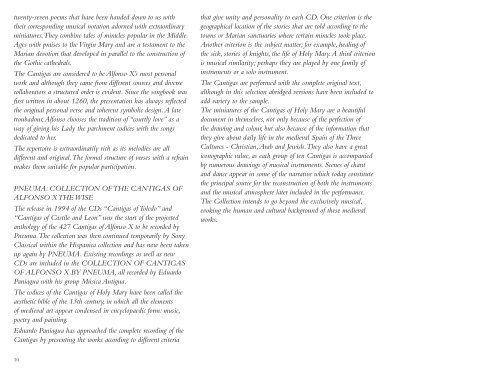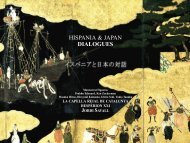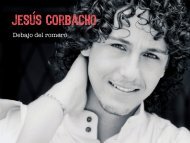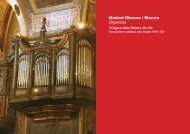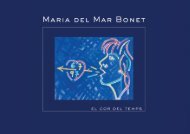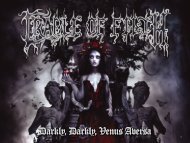“El poder espiritual de la música antigua” “Spiritual power of Early ...
“El poder espiritual de la música antigua” “Spiritual power of Early ...
“El poder espiritual de la música antigua” “Spiritual power of Early ...
You also want an ePaper? Increase the reach of your titles
YUMPU automatically turns print PDFs into web optimized ePapers that Google loves.
twenty-seven poems that have been han<strong>de</strong>d down to us with<br />
their corresponding musical notation adorned with extraordinary<br />
miniatures. They combine tales <strong>of</strong> miracles popu<strong>la</strong>r in the Middle<br />
Ages with praises to the Virgin Mary and are a testament to the<br />
Marian <strong>de</strong>votion that <strong>de</strong>veloped in parallel to the construction <strong>of</strong><br />
the Gothic cathedrals.<br />
The Cantigas are consi<strong>de</strong>red to be Alfonso X’s most personal<br />
work and although they came from different sources and diverse<br />
col<strong>la</strong>borators a structured or<strong>de</strong>r is evi<strong>de</strong>nt. Since the songbook was<br />
first written in about 1260, the presentation has always reflected<br />
the original personal verse and coherent symbolic <strong>de</strong>sign. A <strong>la</strong>te<br />
troubadour, Alfonso chooses the tradition <strong>of</strong> “courtly love” as a<br />
way <strong>of</strong> giving his Lady the parchment codices with the songs<br />
<strong>de</strong>dicated to her.<br />
The repertoire is extraordinarily rich as its melodies are all<br />
different and original. The formal structure <strong>of</strong> verses with a refrain<br />
makes them suitable for popu<strong>la</strong>r participation.<br />
PNEUMA: COLLECTION OF THE CANTIGAS OF<br />
ALFONSO X THE WISE<br />
The release in 1994 <strong>of</strong> the CDs “Cantigas <strong>of</strong> Toledo” and<br />
“Cantigas <strong>of</strong> Castile and Leon” was the start <strong>of</strong> the projected<br />
anthology <strong>of</strong> the 427 Cantigas <strong>of</strong> Alfonso X to be recor<strong>de</strong>d by<br />
Pneuma. The collection was then continued temporarily by Sony<br />
C<strong>la</strong>ssical within the Hispanica collection and has now been taken<br />
up again by PNEUMA. Existing recordings as well as new<br />
CDs are inclu<strong>de</strong>d in the COLLECTION OF CANTIGAS<br />
OF ALFONSO X BY PNEUMA, all recor<strong>de</strong>d by Eduardo<br />
Paniagua with his group Música Antigua.<br />
The codices <strong>of</strong> the Cantigas <strong>of</strong> Holy Mary have been called the<br />
aesthetic bible <strong>of</strong> the 13th century, in which all the elements<br />
<strong>of</strong> medieval art appear con<strong>de</strong>nsed in encyclopaedic form: music,<br />
poetry and painting.<br />
Eduardo Paniagua has approached the complete recording <strong>of</strong> the<br />
Cantigas by presenting the works according to different criteria<br />
10<br />
that give unity and personality to each CD. One criterion is the<br />
geographical location <strong>of</strong> the stories that are told according to the<br />
towns or Marian sanctuaries where certain miracles took p<strong>la</strong>ce.<br />
Another criterion is the subject matter; for example, healing <strong>of</strong><br />
the sick, stories <strong>of</strong> knights, the life <strong>of</strong> Holy Mary. A third criterion<br />
is musical simi<strong>la</strong>rity; perhaps they are p<strong>la</strong>yed by one family <strong>of</strong><br />
instruments or a solo instrument.<br />
The Cantigas are performed with the complete original text,<br />
although in this selection abridged versions have been inclu<strong>de</strong>d to<br />
add variety to the sample.<br />
The miniatures <strong>of</strong> the Cantigas <strong>of</strong> Holy Mary are a beautiful<br />
document in themselves, not only because <strong>of</strong> the perfection <strong>of</strong><br />
the drawing and colour, but also because <strong>of</strong> the information that<br />
they give about daily life in the medieval Spain <strong>of</strong> the Three<br />
Cultures - Christian, Arab and Jewish. They also have a great<br />
iconographic value, as each group <strong>of</strong> ten Cantigas is accompanied<br />
by numerous drawings <strong>of</strong> musical instruments. Scenes <strong>of</strong> chant<br />
and dance appear in some <strong>of</strong> the narrative which today constitute<br />
the principal source for the reconstruction <strong>of</strong> both the instruments<br />
and the musical atmosphere <strong>la</strong>ter inclu<strong>de</strong>d in the performance.<br />
The Collection intends to go beyond the exclusively musical,<br />
evoking the human and cultural background <strong>of</strong> these medieval<br />
works.


